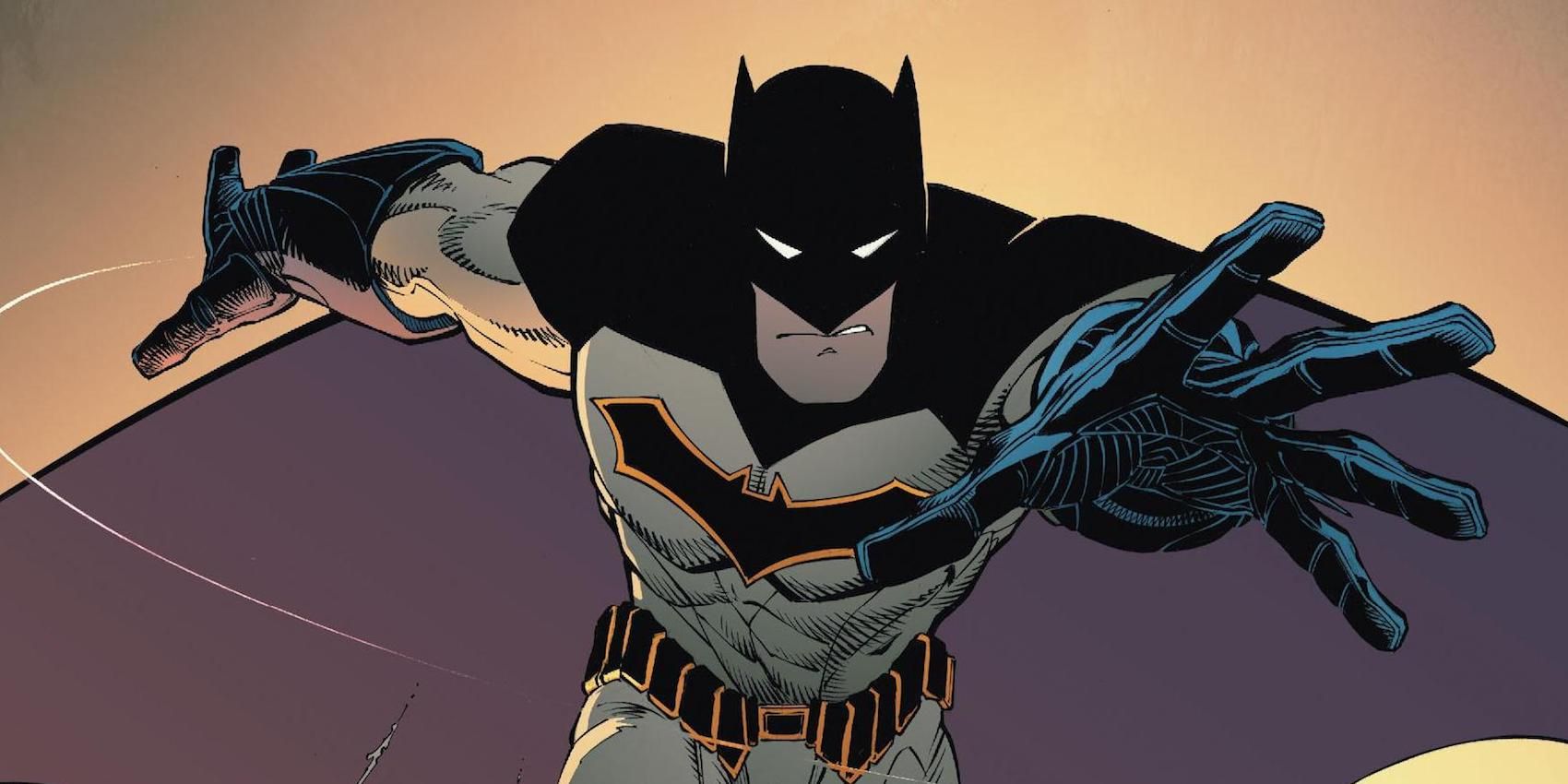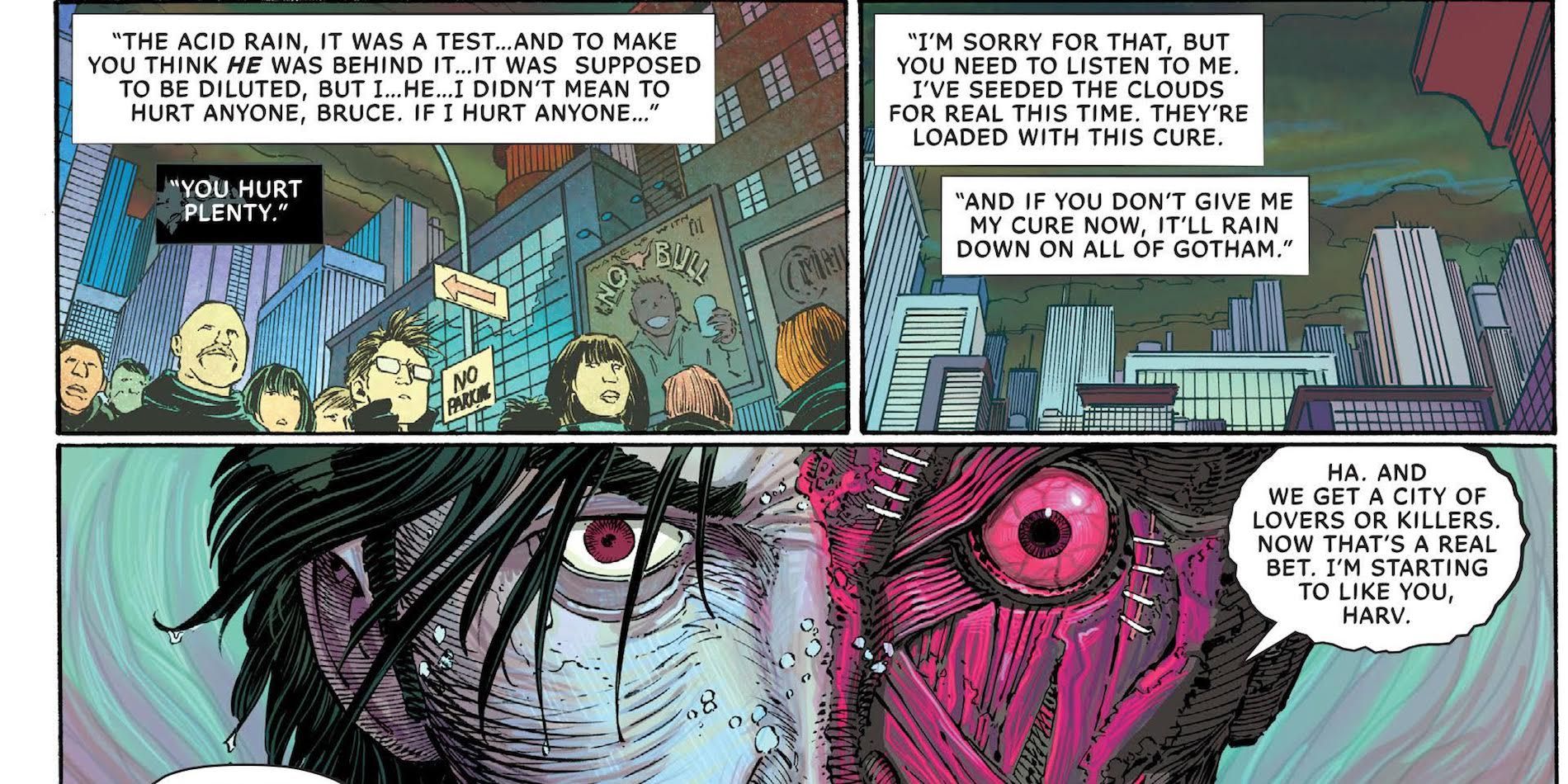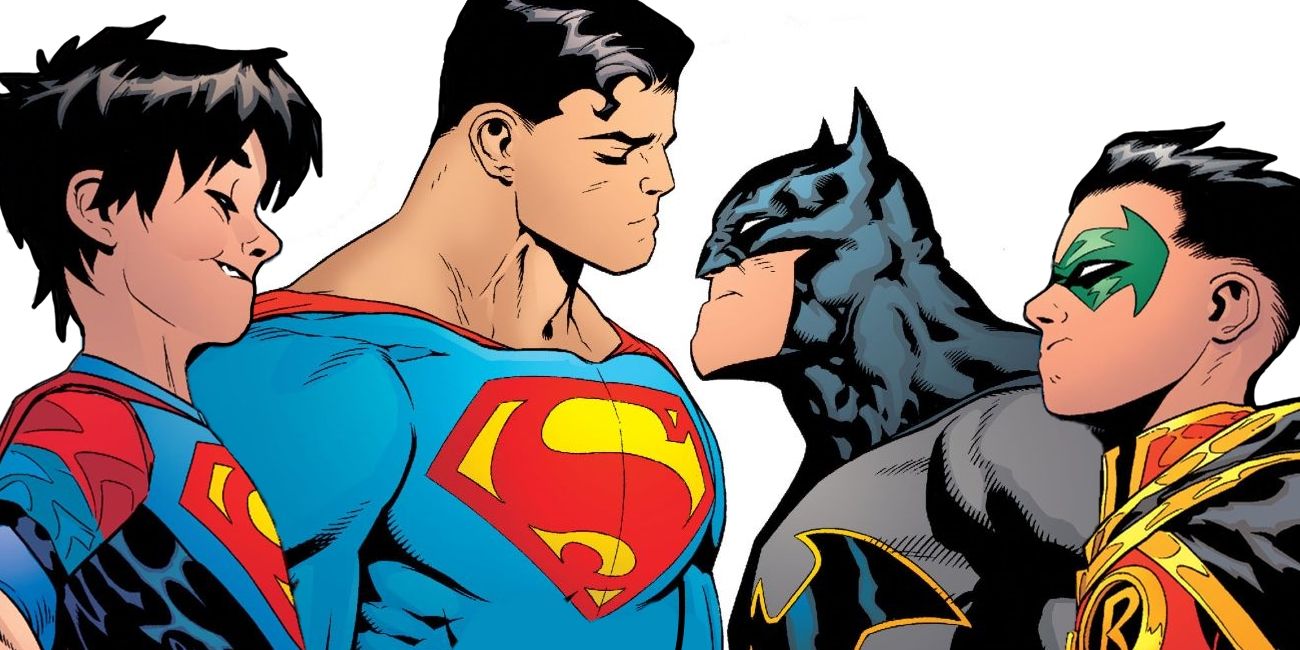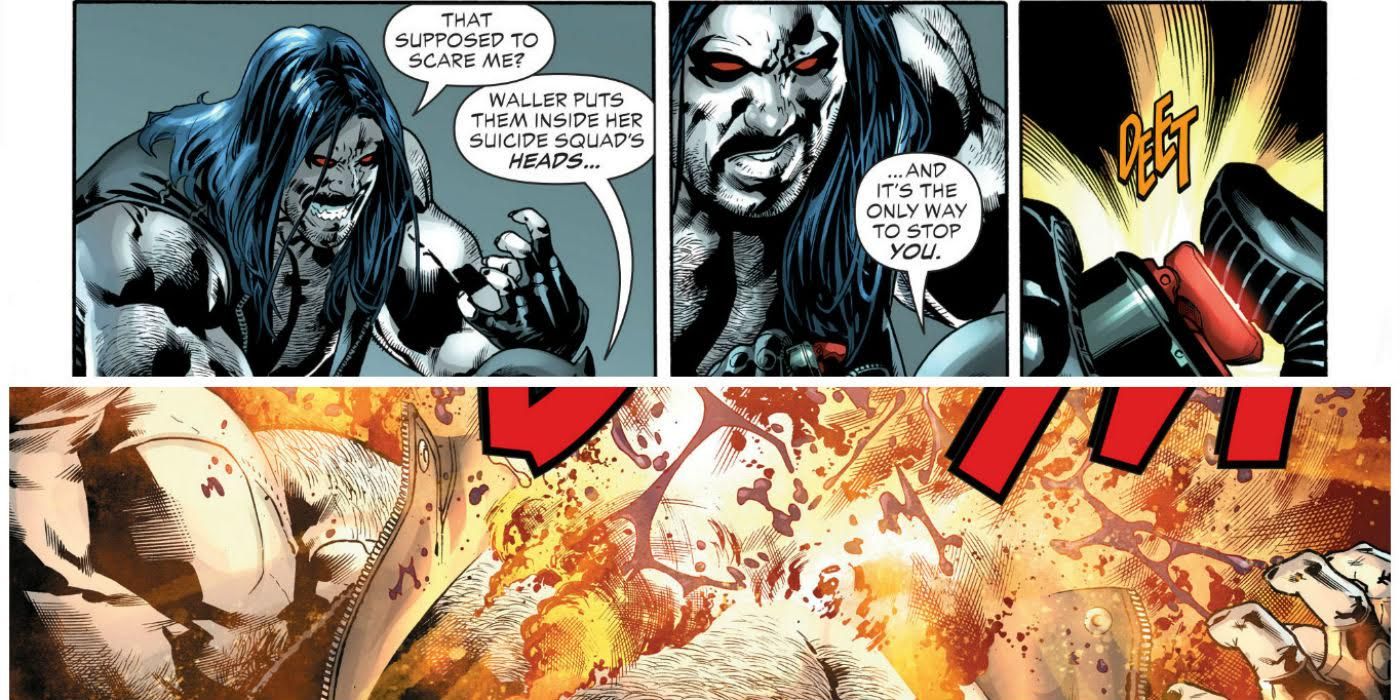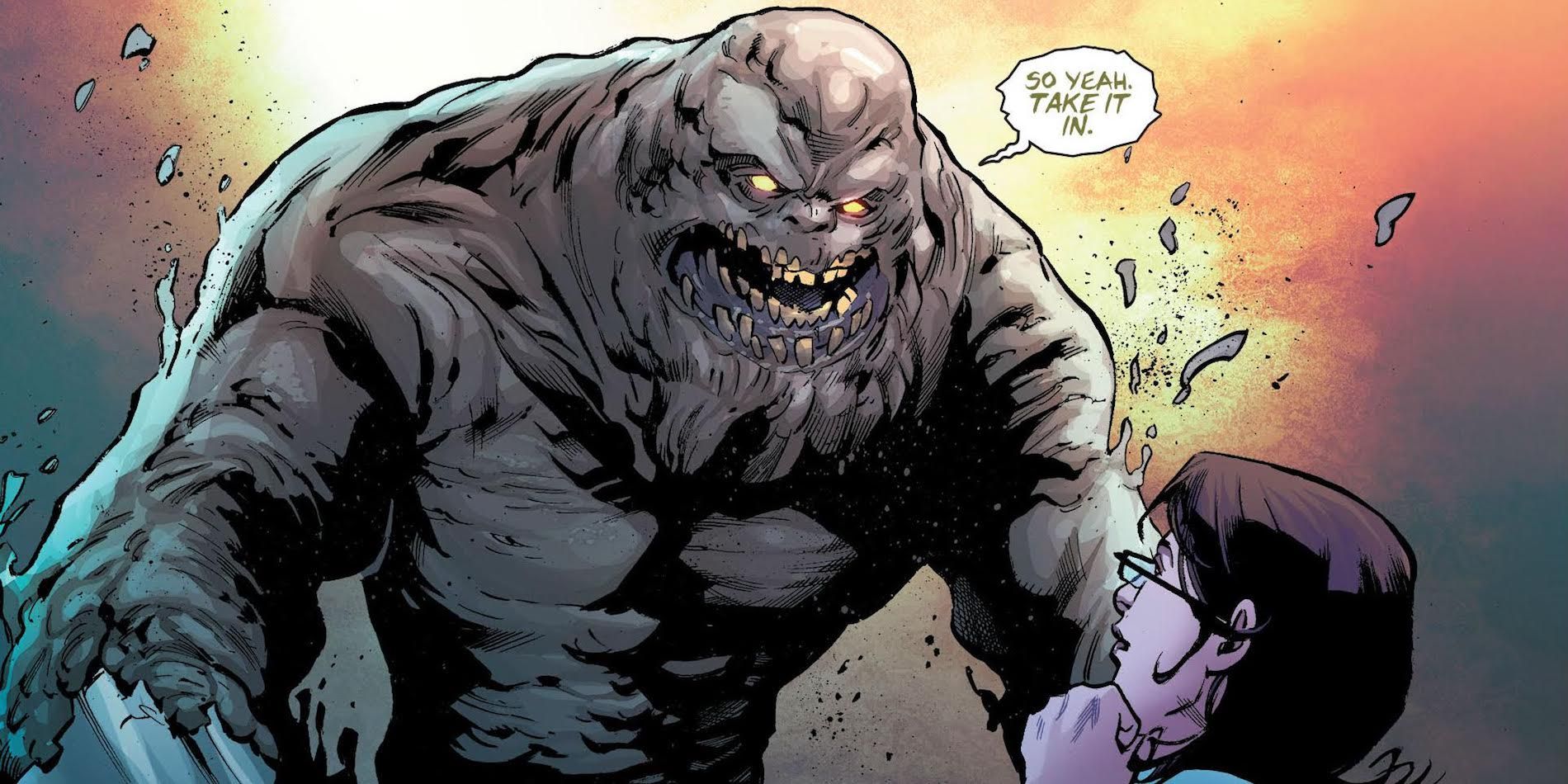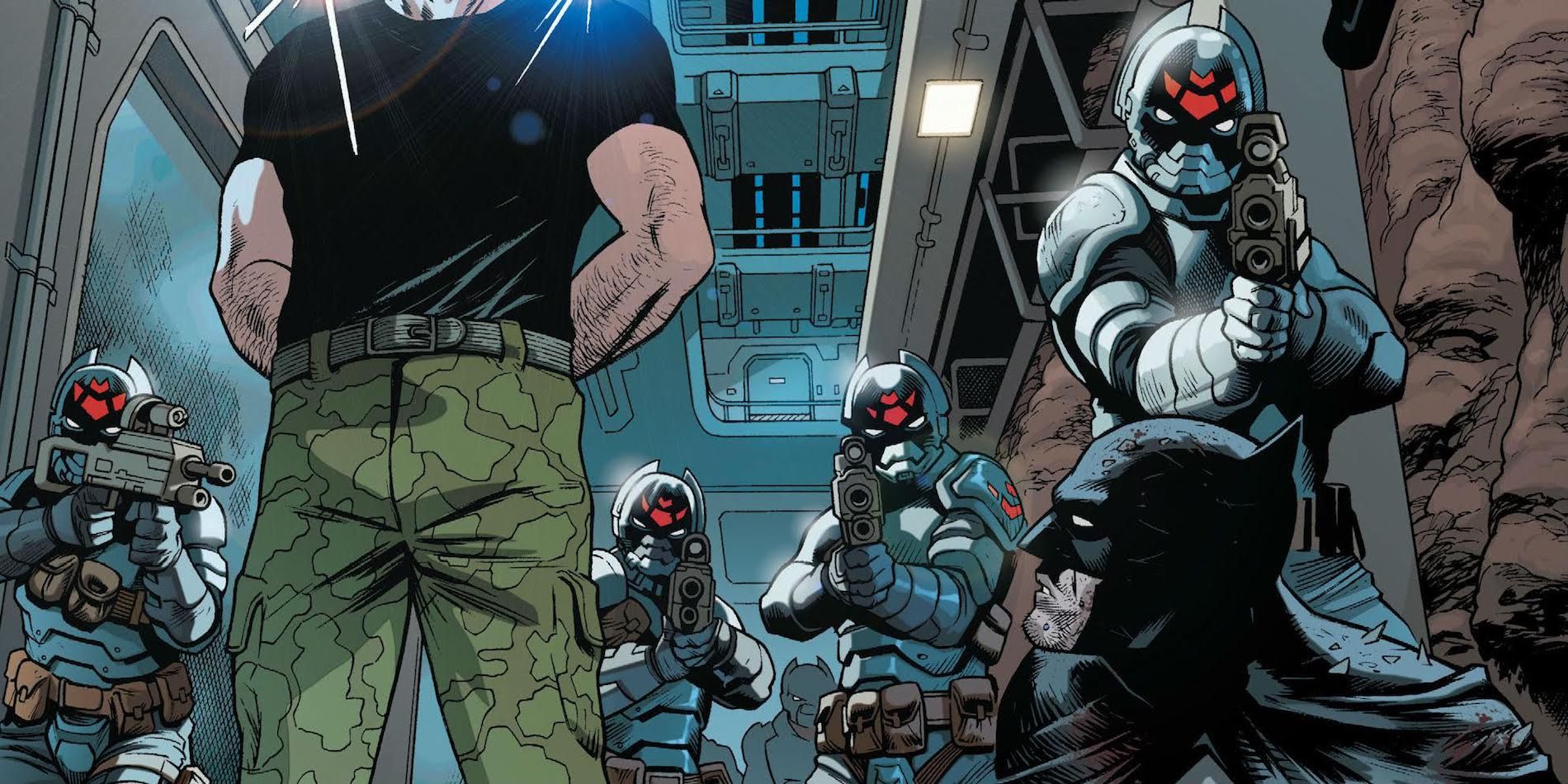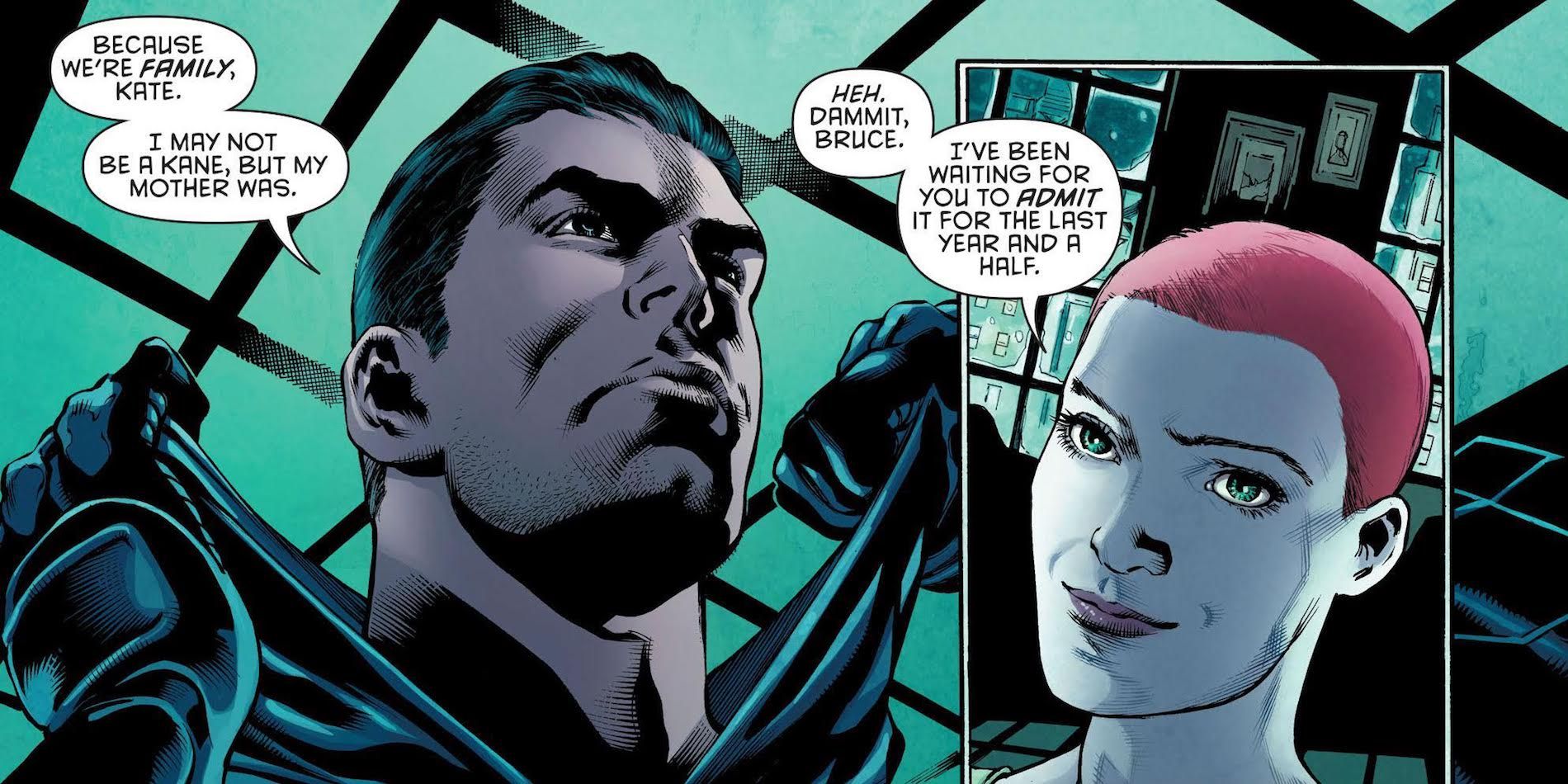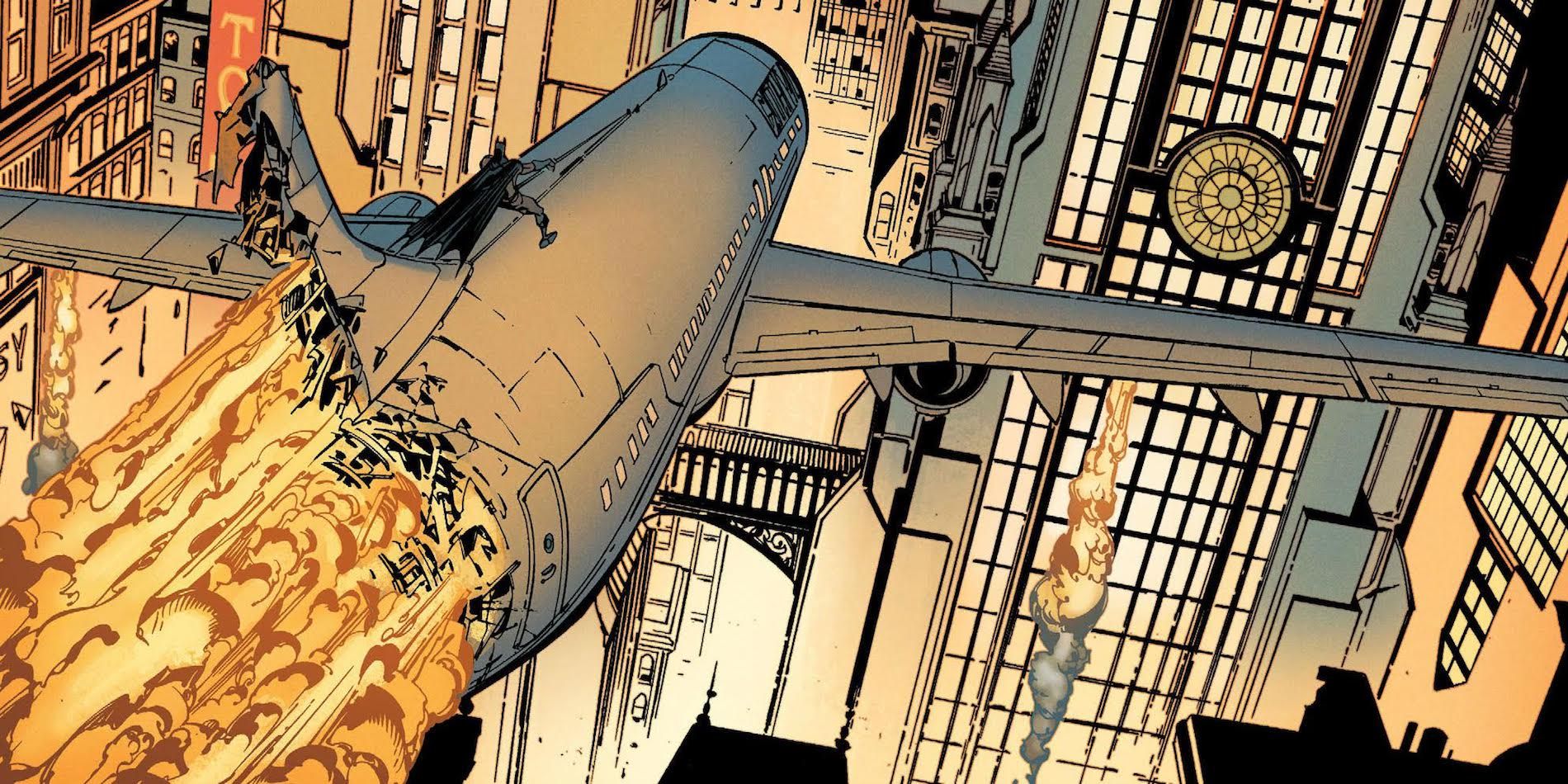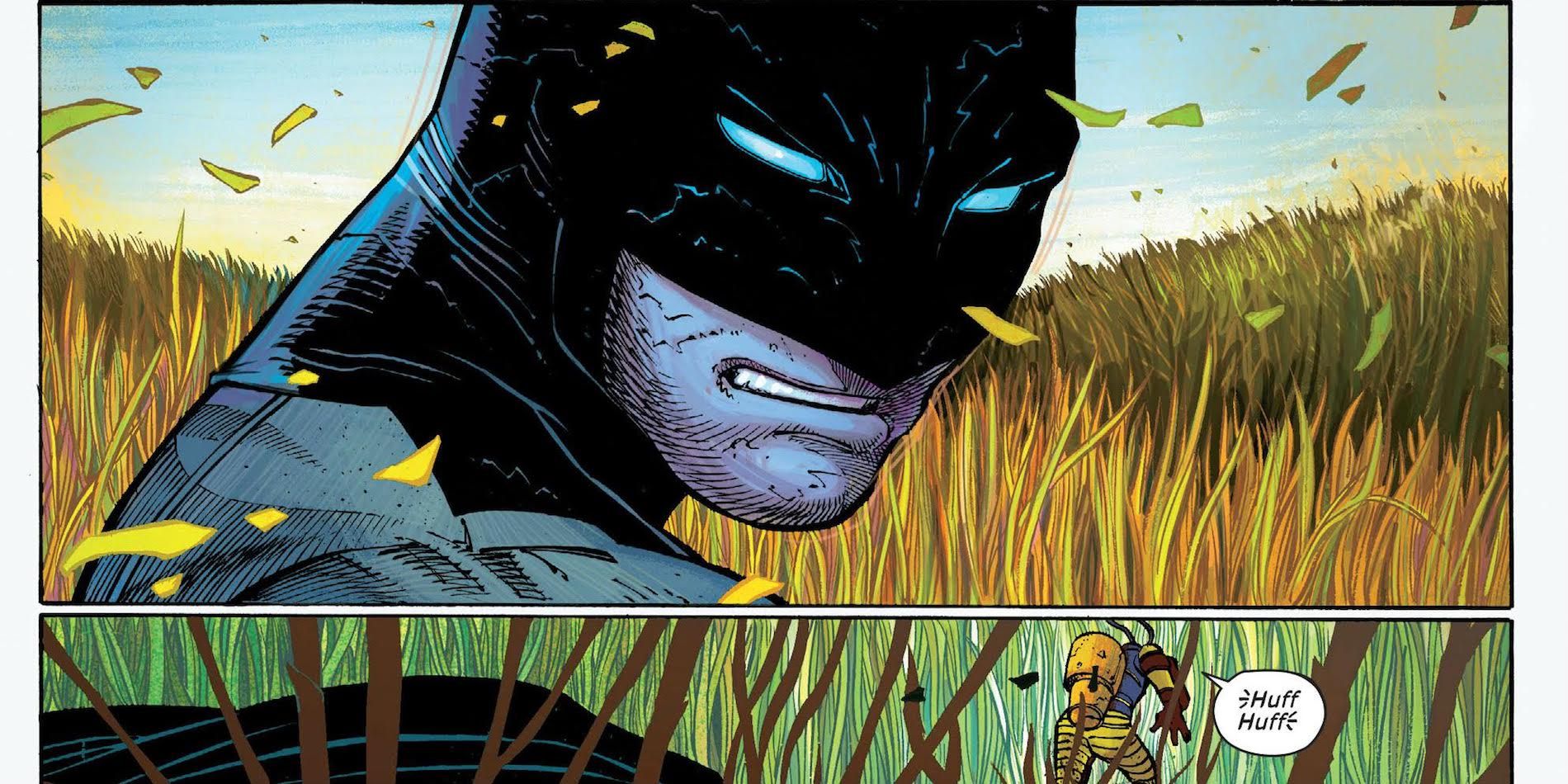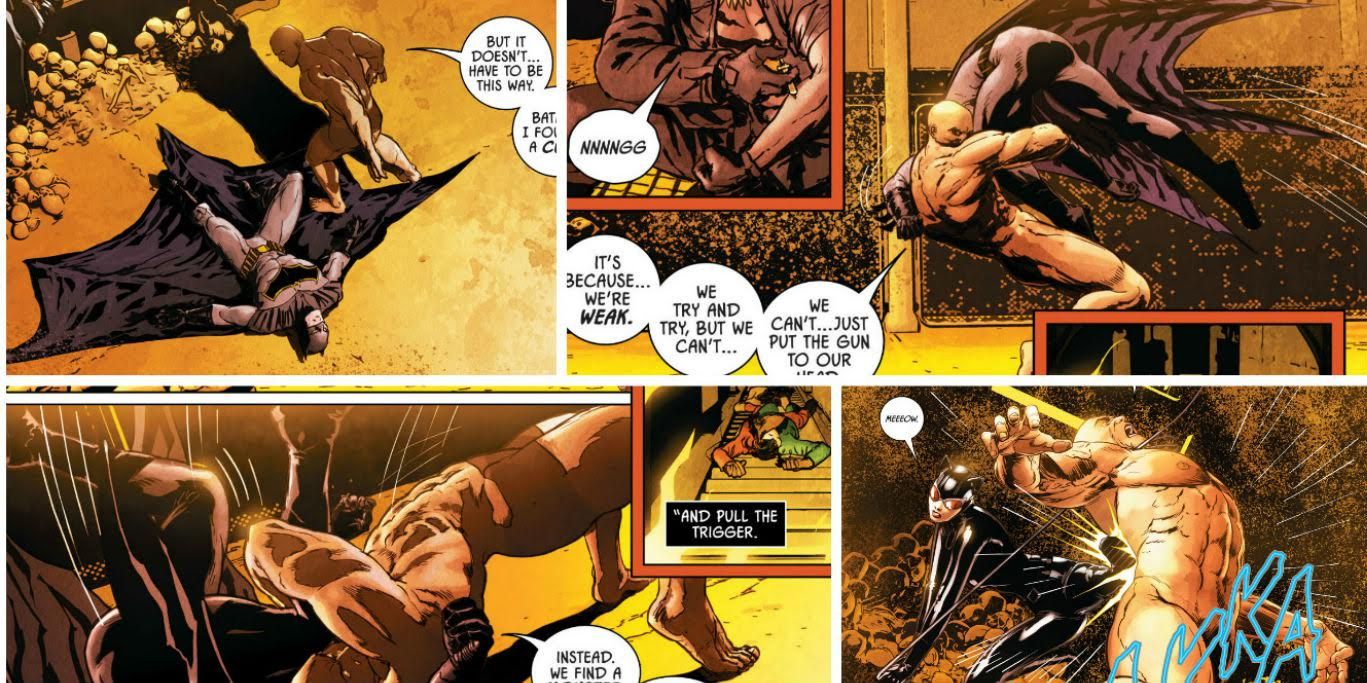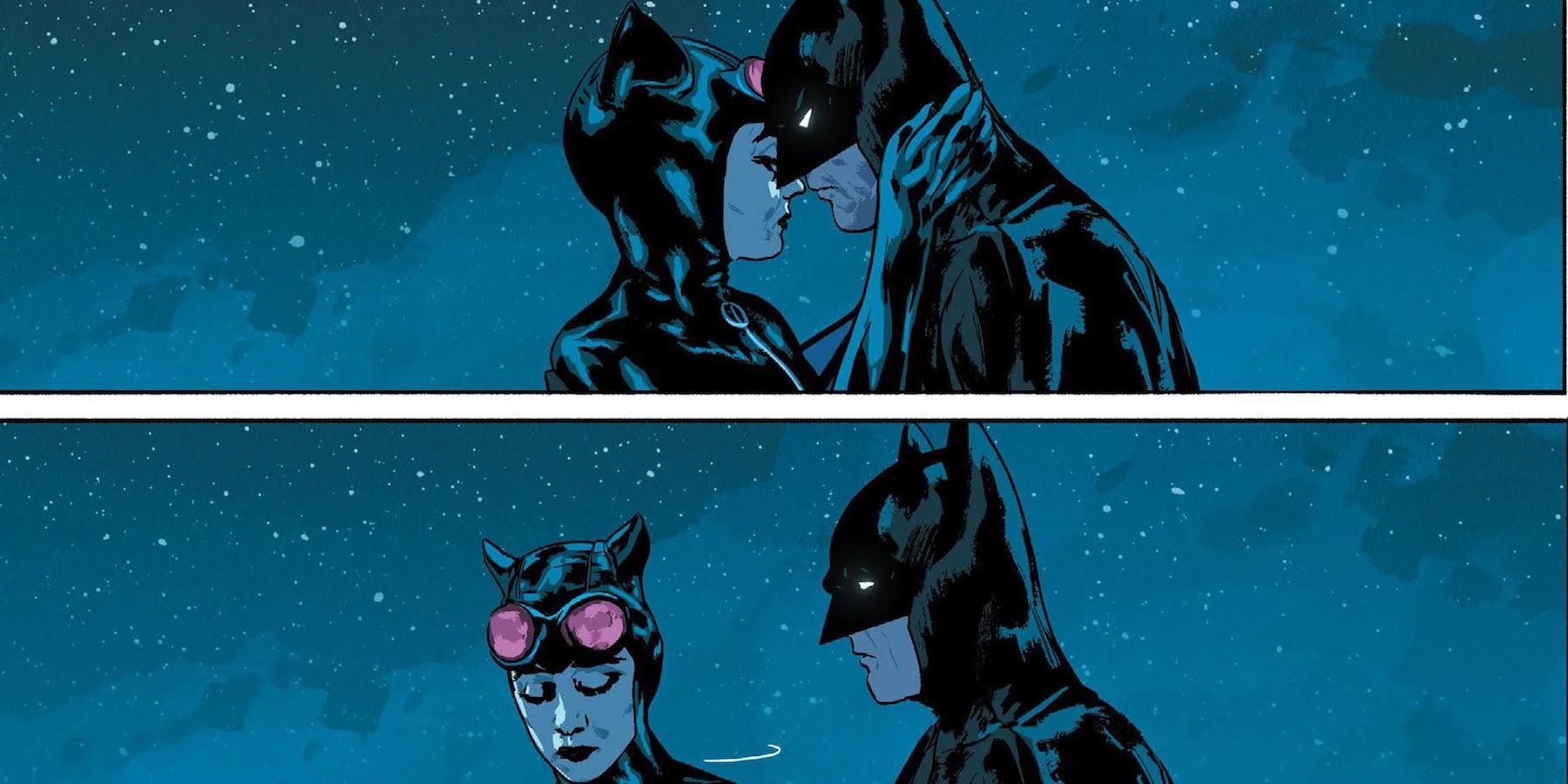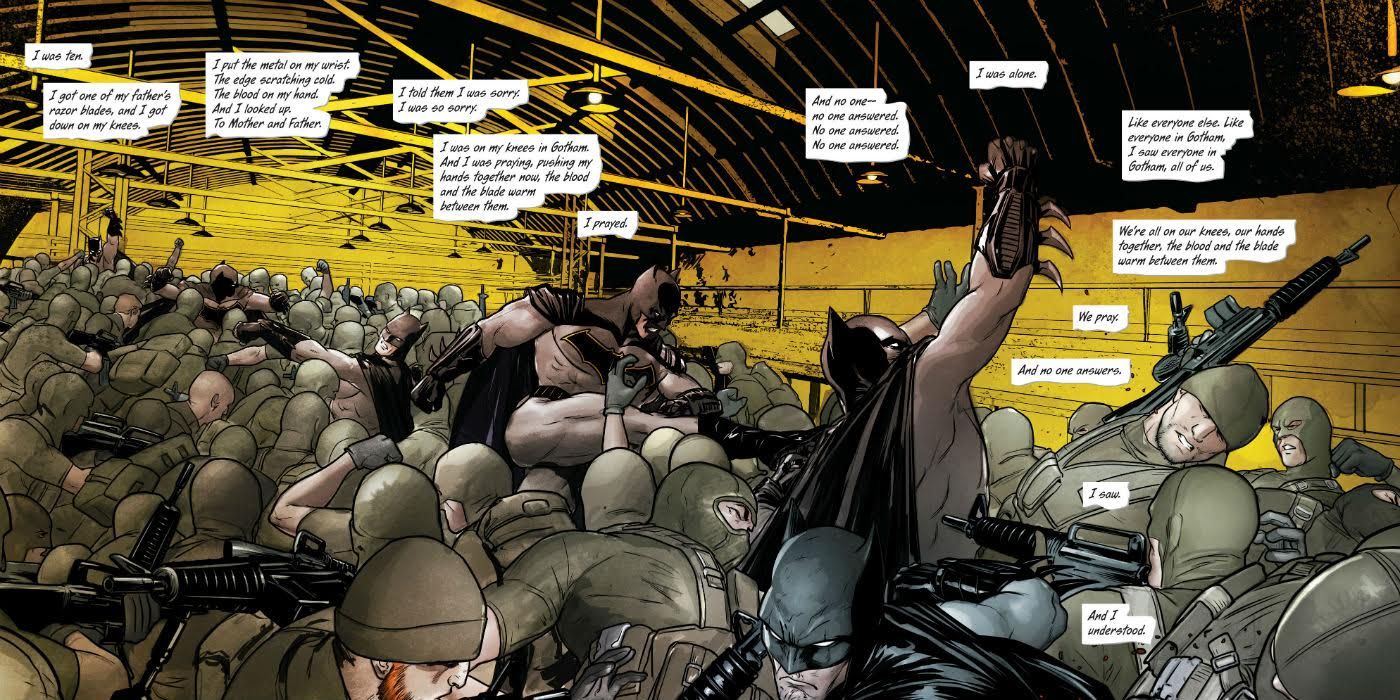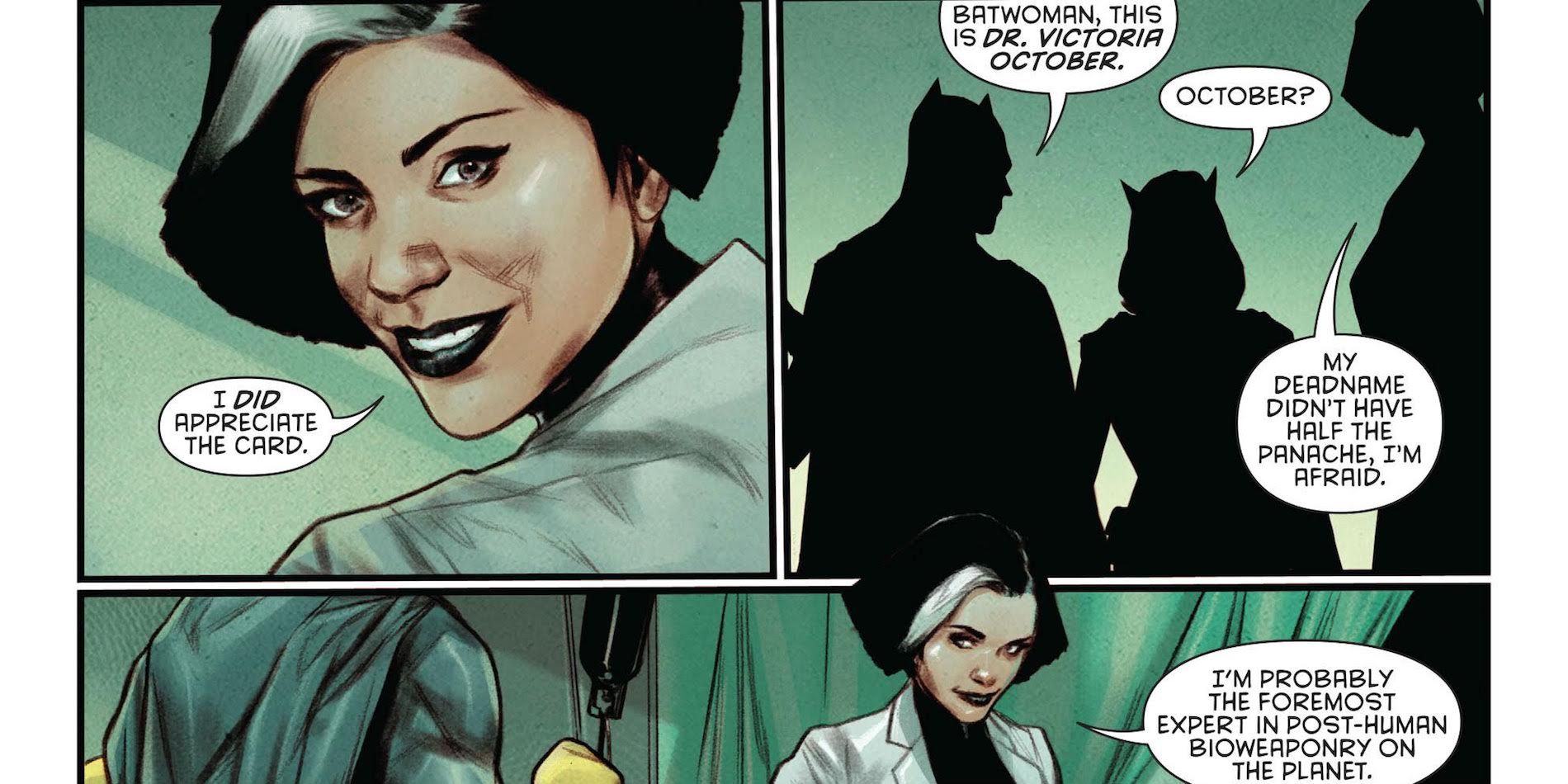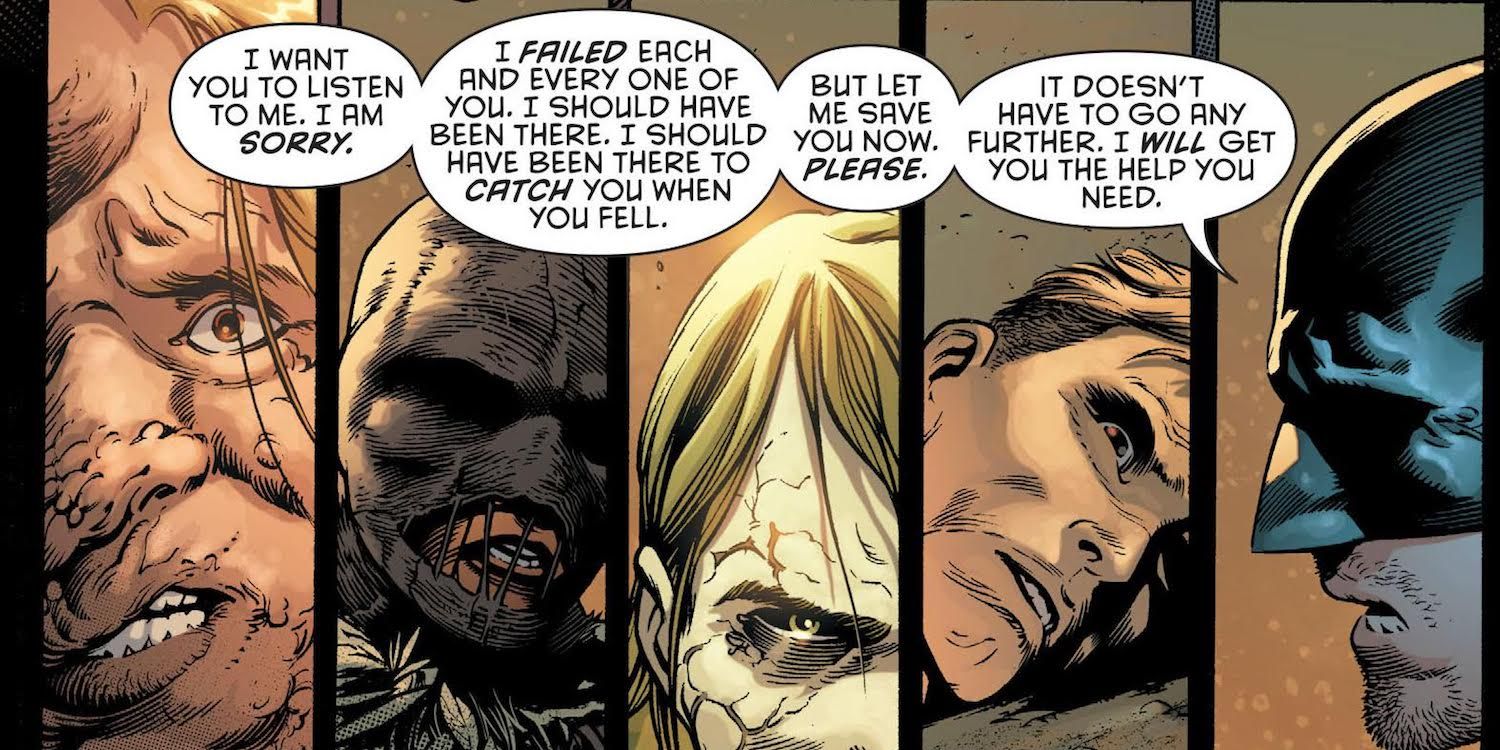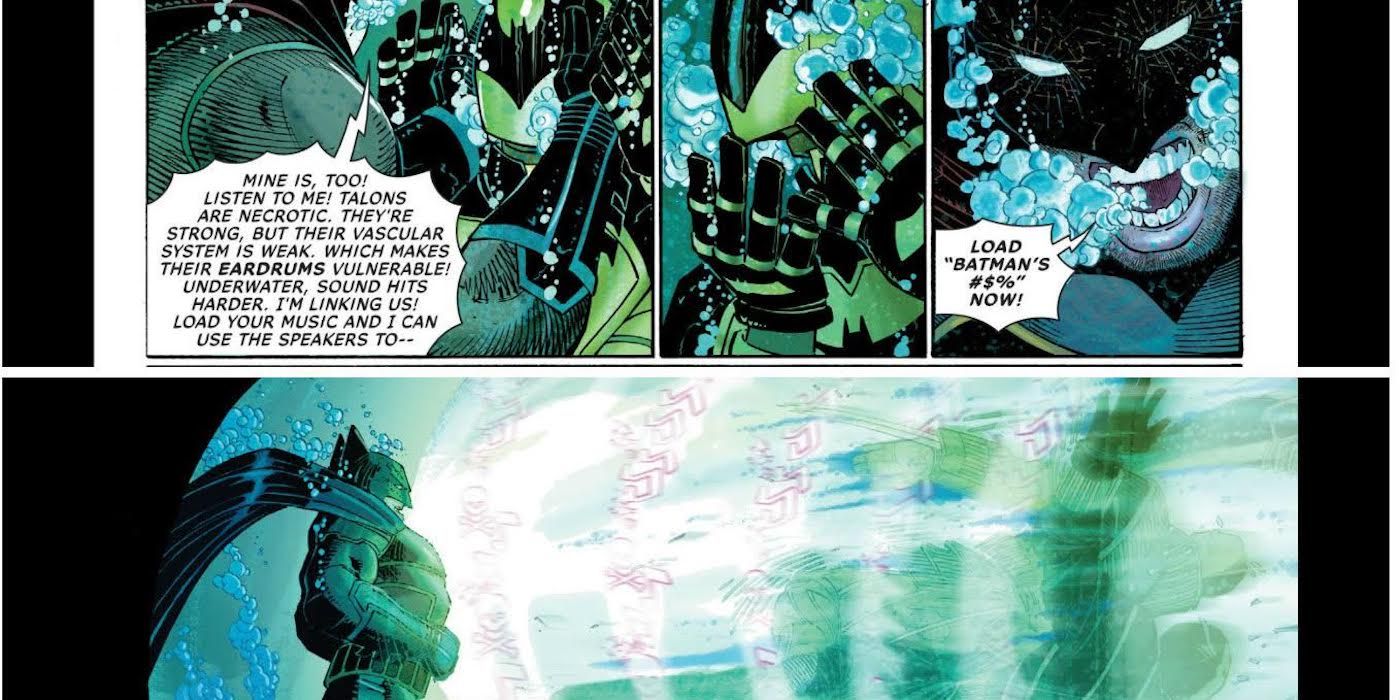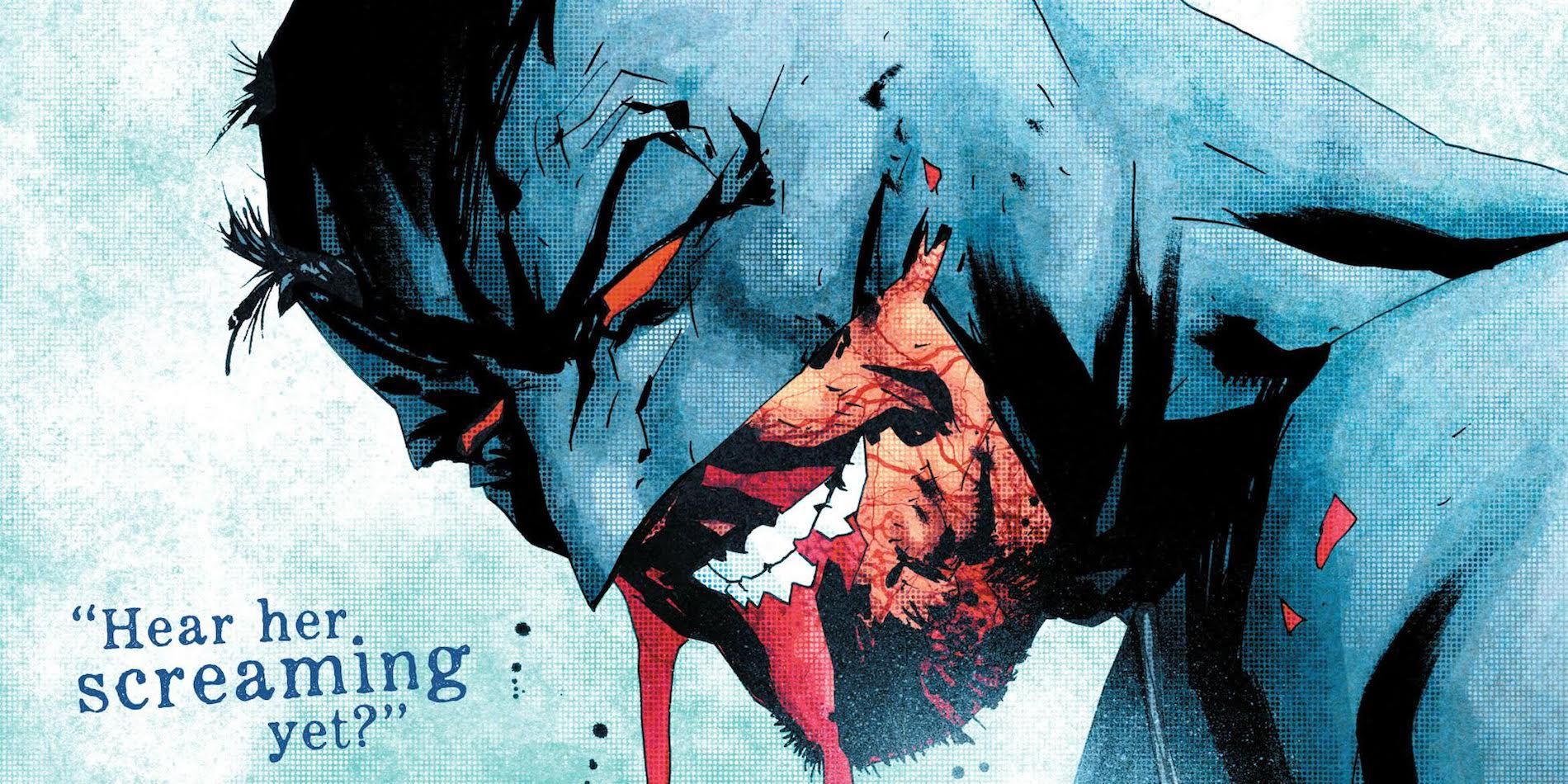When DC Comics launched their Rebirth line, new status quos and creative teams were brought on board. While the Batman line didn’t really need fixing the way the Superman line did, the changes made have not only been great, they’d also added something to Batman that we didn’t even know we wanted: absolute balls to the wall insanity. From Batman forming a team to fight an army of government-created Batman soldiers, to smiley-faced buttons randomly appearing in bedrock, to breaking into prisons on foreign soil, and trying raise more child soldiers, the Dark Knight hasn’t been this colorful or strange since the '60s.
But crazy isn’t Batman’s only ingredient. The content has gotten even darker and nastier than before, pushing the limit of what’s allowable in mainstream comics. Violence, sex, depression, and another dead Robin -- what more could you want? Without further ado, here is DC Rebirth: Batman's 16 Best Moments So Far.
16. Complicating the Batman/Two-Face Dynamic
Peter J. Tomasi’s “The Big Burn” added extra dysfunction to Batman and Two-Face’s relationship by making them childhood friends. Bruce is now partially responsible for Harvey being disfigured, and Dent now being aware that Bruce Wayne is Batman makes Two-Face’s hatred much more streamlined and efficient. That’s an important thing for villains.
Scott Snyder’s “My Own Worst Enemy” takes it further by exploring Bruce and Harvey as children attempting to overcome trauma — the dead family and the abusive parent. Like any good superhero, The Dark Knight takes on the guilt of Harvey’s instabilities and is obsessed with saving Harvey from Two-Face.
Nobody knows how to hurt you like a friend, so their conversations are sharply edged, teeming with a history-heavy insight. At the end, it’s revealed that Harvey was responsible for one of Two-Face’s crimes, creating a catalyst for Batman to try and cure him. Now, even Bruce’s few positive memories of childhood are tainted, making him question if Harvey was ever a good man.
15. The New World’s Finest
In the New 52, Batman and Superman still had a complex relationship (mostly because Supes was kind of a dick), but they bonded over a common link: as per comic book law, their parents were murdered when they were young. Rather than curse the capricious acts of an uncaring god editor, they became superheroes.
Now, the New 52 Superman has been thankfully replaced by the original Man of Steel, who is older, wiser, and remembers a different Justice League in a different reality. Batman doesn’t trust him, naturally. This isn’t his Superman, after all. Their relationship starts at zero again, only now the Dark Knight is somewhat younger and Supes is somewhat older, with different adventures and experiences. But they do have one common factor: their sons are about the same age.
The boys are already BFFs — Damian Wayne kidnapped Jon Kent to run experiments on him, and Jon blasted Damian with heat vision. Fatherhood humanizes Bruce and Clark, as well as creates a means for them to bond, along with new avenues for stories and conflict. The core of the Batman/Superman relationship is still the same, but the factors and the details are more mature than they’ve ever been.
14. Batman Blows off Lobo’s Head
Lobo was created by Roger Slifer and Keith Giffen as a parody of contemporary grim and gritty characters like Wolverine, Punisher, and Cable. Proving to be a fan favorite, eventually, he was no longer played for laughs and started being taken seriously. As an incisive joke, Lobo was a fun character. Played seriously, he’s a cookie cutter edgy character that borders on tedium.
In the recent Justice League vs. Suicide Squad event, Lobo joined the latter team. This offended Batman, who used Amanda Waller’s deterrent brain bombs to blow Lobo’s head clean off (don't worry, he's got a powerful healing factor).While in-story, he’s just trying to complete his mission, it’s just more fun to think that Batman was as sick of Lobo’s shtick as fans are.
Bruce was trained by some of the most dangerous people in the world. He learned how to kill so he could measure his force and know when to stop. It’s a rare treat to see the Caped Crusader up against an enemy that would allow him to cut loose. That the scene plays out quickly and nonchalantly makes it even more badass. That it happened to Lobo just makes it good old fashioned schadenfreude.
13. Giving Clayface a Second Chance
Batman’s record in rehabilitating criminals is spotty at best. Adding Clayface to the Caped Crusader's Gotham team is the result of several years of stories that have attempted to paint Basil Karlo in a more sympathetic light. We’re told that Clayface’s brain chemistry was changed in the accident that created him, damaging his ability to know right from wrong, and that Batman cured the mental imbalance with a tech thingy. It’s at once a reasonable explanation (for comics) and an eye-rolling plot device to explain away years of murder and mayhem.
Regardless, it allows Karlo to be more three-dimensional than he's been able to be since Batman: The Animated Series, and reasserts ideas of redemption at the heart of the mythology. Bruce has used his company to hire the homeless, former criminals, and runaways for years, though there hasn’t been much focus on it in recent years.
There’s the minor character Ellie, a teenage prostitute Bats rescued and later employed (as a receptionist, not, you know, as a prostitute). She showed up again in a cameo recently in Detective Comics. The use of Ellie and Clayface is an acknowledgment of the core of what drives Batman. He wants to help people, whether they’re a runaway, a potential soldier in his ever-growing child army, or a deranged actor turned living mudslide.
12. Batman vs. the Army
The Bat Family can give the Manson family real competition when it comes to dysfunction. Bruce’s uncle, Jacob Kane, is a colonel in the US Army, and the father of Batwoman. Kane discovered Batman’s identity, and, impressed with the Dark Knight’s efficacy, started a program called Colony to train members of the military to be exactly like him. The same training, the same tech, but with fewer qualms about killing. Naturally, both sides went to war. Batman vs. the Army. The private sector vs. the establishment. Wayne vs. Kane.
Let that sink in more: Batman fights the military. It’s every bit as crazy and fun as you’d expect. Of course, it’s emotionally traumatizing for the families as they betray and kick the crap out of each other, but for us, it’s absolute gold. The battle sprawls over several issues and pushes Batman to a rare limit: an enemy with superior forces and matching technology. Not even the League of Assassins has gotten this close.
Naturally, it wouldn’t be a major bat-event without the death of a Robin. This time, Tim Drake got the call, making him the last of the five canonical Robins to die...or be thought dead.
11. Developing the Batwoman Connection
Kate Kane — the modern incarnation of Batwoman — debut shortly after Infinite Crisis in 2006. For much of that time, she operated independently, though Batman kept files on her (as is tradition). By adding her as a team co-leader in Detective Comics, this increases her visibility to the audience and gives Batman a foil. Alfred is usually confined to the Manor, Grayson is off showing his abs somewhere, and while Stephanie Brown has never had a problem standing up to Bruce (having yelled at him repeatedly and punched him once before), Kate is portrayed as his equal. Combining work and family is never a good thing, and when the family business does entail a great deal of violence, well, situations get out of hand.
With her father and Batman at odds, Batwoman is caught between loyalties and given more character depth as she deals with the complicated feelings she has for her father and her cousin. It also adds to Bruce himself; the Wayne line has been well explored over the last ten years, while the Kane side of the family was kept blank. Exploring the Kanes gives us an idea of the distance that’s grown between the families and works as a nice confirmation that everyone in this family tree is screwed up.
10. Landing a Plane from the Outside
In season 5 of 24, Jack Bauer took control of a plane from the cargo hold. Recently, Batman did the same, but from on the top of the plane as it was was free-falling. Both are impressive, but we're gonna have to give Bats the W here. Batman's aircraft explodes on its descent toward Gotham as he and Gordon were hanging out on a rooftop. The Caped Crusader immediately goes to work. He, somehow, has supplies in the Batmobile to help him land planes; don't you?
Combining both an insane capacity for preparation, and enough brilliance to do advanced math while driving, he launches the Batmobile off a bridge, hits the ejection seat, and blasts right up onto the hull. Then, using two small portable engines and a freaking rope, he changes the trajectory of the plane repeatedly while in flight, managing to avoid buildings, and aim the plane toward the river.
When it becomes clear that he must go down with the plane, the Dark Knight adapts immediately. Writer Tom King displays Batman’s devotion as he unflinchingly decides to sacrifice himself, putting other people first. In quickly setting up Dick Grayson as his natural successor, he’s thinking about his city one last time, and in saying a sad farewell to Alfred, reminds us of the man under the cowl.
9. Scaring Firefly Away by Looking at Him
It’s hard enough to take Firefly seriously. Sure, his flame-tech can do some serious damage, but fireflies themselves are harmless insects, and his name is Garfield, for crying out loud. He’s named after a lazy cat! So, there’s a price on the heads of Two-Face and Batman, and Firefly and Black Spider are trying to collect. The only thing standing in their way is their incompetence and the fact we’re only eight pages into a five part story.
It’s the middle of the day in a cornfield when they elect to attack. Mind you, Batman’s costume works at night, detaching from shadows and striking fear. In the day time (in a cornfield!), he looks silly. But then he turns a chainsaw on Black Spider, freaking Firefly out. This gets Bruce’s attention, and he turns around and just glares at Firefly, who takes off like he just had Taco Bell with a side of dysentery. Batman lets him go; he’s made his point.
8. Outsmarting and Outfighting Bane
The first time they met, Bane outsmarted Batman. He worked from the shadows and waited until Bruce was exhausted. Then, he invaded the cave and broke the Dark Knight’s back. Bane did all this on Batman’s territory.
They would encounter each other from time to time, but no matter what, there was a sameness to their encounters. There was hardly anything new to add to their enmity until now. In I am Suicide, a naked Bane suplexes Batman. Ladies and gentlemen, we’re beyond the red line now.
I am Suicide is a mirror of Knightfall. This time, it’s Bruce who does the planning and operates from the shadows. He invades Santa Prisca and confronts Bane, who is free of his Venom addiction, nude (he is at home after all), and out to prove once again he’s Batman’s superior. And that’s when the Caped Crusader does it. They fight, but Batman still has one last thing to prove: he’s smarter.
The fight ends with Batman victorious and Bane’s back broken after being betrayed by Catwoman, who Bruce planted as a triple agent. Bat-mic drop.
7. Catwoman
The relationship between Batman and Catwoman has always been about the attraction to danger. Both are outlaws by nature, though they stand on different sides even when they’re supposed to be on the same one. Selina could forgive a friend who has committed murder, Bruce cannot. Following Rebirth, their relationship has changed again. Bruce and Selina knew each other as kids, if only in passing. She lived in an orphanage run by the Wayne family, and the orphanage was blown up by terrorists. Selina is later accused of murdering the terrorists. It’s now Batman’s job to bring her in.
Never has their relationship been so sexualized, so honest, or so sad. Sure, this is only the beginning of the Rebirth status quo, but even as they recount their differing memories from how they met (apparently, somehow, Selina remembers being black in Batman: Year One; you’d think she’d have some questions regarding that) there’s an undeniable feeling of ending. When it doesn’t, and the game is clearly meant to continue, there’s still an inescapable sense of loss.
Comics have come a long way since Archie.
6. Suicide Attempt
Continuing with the theme of depression, Bruce recently revealed that he attempted suicide after his parents’ murder. It’s revealed in the form of a letter he writes to Selina Kyle while she's in prison (more on that shortly). With more self-awareness than anybody thought he was capable of, he admits how ridiculous it is running around with pointy ears and beating people up. He tells the story of taking a blade to his wrist and opening his skin, the blood warming his hand. But that wasn’t the true suicide attempt. In the emptiness and the sudden mortality he felt in that moment, that’s what made him realize his mission.
The mission of Batman is to die. There is no hope for Bruce being Batman. It's his suicide attempt, his suicide note. His promise that he’s going to die helping others. In Catwoman, he sees a mirror image. Someone whose life was defined by a violent act as well. He’s attracted to her because she’s the only person who understands it, and when they’re together, he feels like he isn’t dying alone. He still doesn’t feel good, but he feels less alone.
Man, this is a fun list.
5. Further Diversity
A few years ago, in the pages of Batgirl, Gail Simone introduced DC’s first transgender character, Alisa Yeoh, as Barbara Gordon’s roommate. Eventually, Alisa married and Babs went to her wedding. Bruce Wayne, however, doesn’t really have friends. In a recent issue of Detective Comics, we were introduced to the stunning and brave Dr. Victoria October, one of Batman’s allies. While she only appeared briefly, it is revealed that she recently went through gender reassignment surgery and that she received a card from him. Whether that means that she knows that Bruce Wayne is Batman or that Batman sends letters to people -- we don’t know. If it’s the latter, does he sign his letters Batman? Or does he stamp his symbol on them, like in Batman Returns? Do you think he uses wax seals? He seems like he does.
We’re getting off-topic here.
The point is, this is a new frontier for DC Comics, and for comics in general. This wasn’t happening ten years ago. It wasn’t even happening five years ago. Now, there are comics for everyone and characters for everyone. As large and diverse as comics and the worlds they explore are, they’ve never felt closer to reality than they do right now.
4. The First Victim
In Gotham, supervillains didn’t start showing up until after Batman took to the streets. Of course, crime created Batman in the first place, so there’s this cyclicality to the whole thing anyway. In a recent Detective Comics arc, we’re exposed to the unintended consequences of the Dark Knight’s mission: collateral damage. A group calling themselves The Victim Syndicate sets its sights on the Caped Crusader, whom they blame for their problems. Each of them have had their lives altered by supervillains when they were in the wrong place at the wrong time.
Rethinking Batman’s mission as a war is very post-9/11, and gives a kind of modern Chicago twist to Gotham, where stray bullets hit unsuspecting people daily. It’s sobering, adult, brilliant, and ugly at the same time. To writer James Tynion IV’s credit, his Dark Knight doesn’t know how to respond to this threat at first. Yes, the Syndicate’s committing crimes and it needs to stop, but they do have a point.
Batman’s Jean-Luc Picard-like speech at the end acknowledges his own responsibility in the tragedy the Syndicate members experienced, and though cathartic, both parties know that it doesn’t change anything.
3. Batman’s #$%^
Okay, let’s get to something a bit less depressing. Did we do that naked Bane thing? Yes? Damn it. Okay, well, here’s something that’s fun too. On the other end of the Victim Syndicate, and an outright win for the Dark Knight, is a metal band of ex-Arkham inmates who turned their lives around. They’re popular in Gotham. They’re called “Batman’s #^@$.” Hey, at least they’re not out committing crimes; a victory’s a victory.
Introduced to the group’s music by Duke Thomas, Batman considers suing them (for slander or copyright, we're not too sure), though Bruce does come to like the group — specifically when he used the band’s music as a sonic blaster when he was fighting the Court of Owls underwater (never change, comics).
The heartbreaking thing is that we may never know which body part of Batman’s they’re referring to, and we may never actually hear any songs by Batman’s #&@%, but we can only hope it’s half as good as this.
2. Mr. Freeze
In the classic American film Demolition Man, Sylvester Stallone’s John Spartan opines on the criminal he’s tasked to find. “Send a maniac to catch one,” he grumbles. In the finest tradition of this cinematic masterpiece, Batman scours the artic in a mech suit (this is a Scott Snyder script after all) looking for Mr. Freeze, who is planning on bringing about a new Ice Age. It’s a standard Victor Fries move, but in invading Freeze’s turf, the Caped Crusader needs an edge.
So the maniac infects himself with a heat virus to kill the extinction-level bacteria frozen in the ice that Freeze is trying to extract. Smiling like the Joker and bleeding like a sieve, the Dark Knight’s skin burns red and looks more villainous than the cold-based villain himself. Batman’s “Hear her screaming yet?” is frightening and miserable, and as they fight it out — fire vs. ice — Bruce breaks down Freeze’s psyche while destroying the base.
Batman succeeds, and in the most surprising moment of the story, cracks Freeze’s emotionless soul, and we see the villain reduced to a screaming, broken mess.
The Dark Knight is, well, dark, and can easily be used in villainous ways. It’s done rarely, so when he does act out so viciously, the impact is brutal.
1. The Watchmen Connection
Arguably the most shocking moment in DC Comics history since Superman threatened to kill Prankster for putting pennies in his ears, we learn in Rebirth that Alan Moore’s Watchmen is now at least somewhat in continuity. Doctor Manhattan is revealed to be responsible for the New 52 — no greater crime could ever be committed — a fact driven home by Batman discovering the iconic blood streaked smiley-face pin in the batcave.
With whatever is coming next, a small contingent of Justice League members are investigating the problem. Superman, Wonder Woman, Wally West, and Barry Allen (the less interesting Flash; admit it, you know it’s true) have all had their lives in some way altered by Doctor Manhattan, and now the World’s Greatest Detective is on the trail of an antagonist that can rewrite history and alter time as he pleases; a dude who can create and destroy on a whim. Essentially, DC Comics is building up to a story where Batman fights god.
Place your bets/pre-orders now.
--
What are some of your favorite Bat moments in Rebirth so far? Are you enjoying the insanity thus far, or is DC taking things a bit too far for your tastes? Let us know in the comments.

